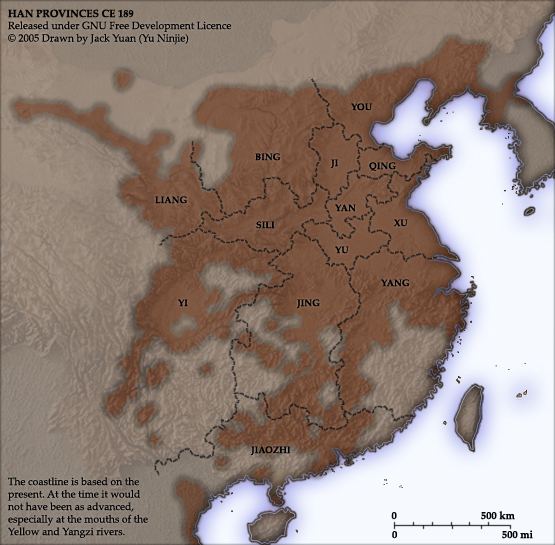Era Eastern Han dynasty | ||
 | ||
Language family Sino-TibetanSiniticEastern Han Chinese | ||
Eastern Han Chinese or Later Han Chinese is the stage of the Chinese language revealed by poetry and glosses from the Eastern Han period (first two centuries AD). It is considered an intermediate stage between Old Chinese and the Middle Chinese of the 7th-century Qieyun dictionary.
Contents
Dialects
Several texts contain evidence of dialectal variation in the Eastern Han period. The Fangyan, from the start of the period, discusses variations in regional vocabulary. By analysing the text, Paul Serruys identified six dialect areas: a central area centred on the Central Plain east of Hangu Pass, surrounded by northern, eastern, southern and western areas, and a southeastern area to the southeast of the lower Yangtze.
Eastern Han texts contain little information on the southeastern dialects, but the Eastern Jin writer Guo Pu describes them as quite distinct from other varieties. Jerry Norman called these Han-era dialects Old Southern Chinese, and suggested that they were the source of common features found in the oldest layers of modern Yue, Hakka and Min varieties.
The Eastern Han glosses provide limited coverage of the remaining areas, but often show marked phonological differences. Many of them exhibit mergers that are not found in the 7th-century Qieyun or in many modern varieties. The exception is the Buddhist transcriptions, suggesting that the later varieties descend from Han-period varieties spoken in the Luoyang area.
Phonology
The consonant clusters postulated for Old Chinese had generally disappeared by the Eastern Han period.
One of the major changes between Old Chinese and Middle Chinese is palatalization of initial dental stops and (in some environments) velar stops, merging to form a new series of palatal initials. Either or both of palatalizations are found in several Eastern Han varieties. However, Proto-Min, which branched off during the Han period, has palatalized velars but not dentals. However, the retroflex stops and sibilants of Middle Chinese are not distinguished as separate series in the Eastern Han data.
Some Eastern Han dialects show evidence of the voiceless sonorant initials postulated for Old Chinese, but they had disappeared by the Eastern Han period in most areas. The Old Chinese voiceless lateral and nasal initials yielded a *tʰ initial in eastern dialects and *x in western ones.
Most modern reconstructions of Old Chinese distinguish labiovelar and labiolaryngeal initials from the velar and laryngeal series. However, the two series are not separated in Eastern Han glosses. Thus it seems Eastern Han Chinese had a *-w- medial, like Middle Chinese. Moreover, this medial also occurs after other initials. In addition, Eastern Han Chinese had medials *-r- and *-j-.
In some Eastern Han varieties, words with the Middle Chinese coda -n appear to have vocalic codas. Baxter and Sagart argue that these words had a coda *r in Old Chinese, which became *j in Shandong and adjacent areas, and *n elsewhere.
André-Georges Haudricourt suggested that the Middle Chinese departing tone derived from an Old Chinese final *-s, later weakening to *-h. Several Buddhist transcriptions indicate that *-s was still present in the Eastern Han period.
